Crew 275 – Mission Summary
Crew 275 – ISAE-Supaero (France)
Crew Commander: Jeremy Rabineau
Executive Officer / Crew Engineer: Quentin Royer
Crew Journalist: Marie Delaroche
Health & Safety Officer: Corentin Senaux
Crew Botanist: Adrien Tison
Crew Scientist: Alice Chapiron
Crew Astronomer: Alexandre Vinas
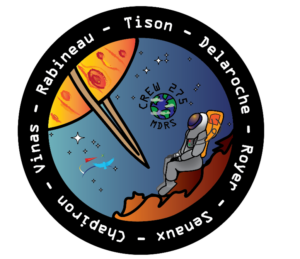
Introduction
Crew 275’s rotation at MDRS marks the 10th time that students from ISAE-Supaero perform research in this station. We are very proud of the progress made between Crew 151, when two Supaero students joined an existing crew, and today: a fully student-run crew, conducting research over the course of a month-long mission at MDRS. This year, our aim was to focus on large-scale human factors experiments, ambitious technological demonstrations, and measurement campaigns in both atmospheric physics and geology.
It’s amazing how quickly we get used to extraordinary things. Upon arriving at the station a month ago, we were facing our dream, facing what we had worked so hard to attain, and for that reason we felt invincible. Over the past weeks, we have dodged storms, lived under Mars’ atmosphere, played by his rules, encountered obstacles, and sometimes unfavorable odds. It is difficult now to look back and see what we have accomplished: it all still feels part of our day to day, of routine operations, and the tiny steps along the way don’t yet add up to the monumental leap we have taken.
Artificial Intelligence for space exploration

AI4U is an artificial intelligence tool designed by the French space agency to assist astronauts in their tasks. AI4U has three functionalities: A « relax » mode, an « emergency » mode, and a mode to retrieve environmental data from all of the modules in the station (temperature, pressure, humidity, luminosity, etc.). The « relax » mode worked well, and thanks to the crew taking turns testing it, we managed to define interesting new tracks for improvement. The emergency mode was tested twice. During the first test, we had difficulties because the AI stopped the emergency protocol in the middle of the simulation, but we managed to finish the protocol successfully after a second iteration.
A second experiment with CNES involved artificial intelligence helping astronauts: EchoFinder. EchoFinder is an experiment conducted in collaboration with CNES and MEDES, consisting in testing a protocol for astronauts to perform ultrasounds without any prior training. This experiment has already been conducted in the past by Supaero crews. This year, the aim was to test a new Augmented Reality interface coupled with an organ detection AI. We have successfully completed the 12 planned sessions, each performed in pairs: the two crewmembers take turns in performing the ultrasound and being subject of the experiment. One injured crewmember did not take part in the experiment during the last week of the mission, and the other crewmembers took turns filling in for her. We have had several issues with this experiment one week into our rotation, mainly because our hardware did not support the EchoFinder software very well. With the help of the researchers from CNES, our crew engineer managed to transfer the software to a more powerful device, which has made the last 8 sessions much easier to perform. After our 4-week mission, we have succeeded in providing the researchers with a complete set of data, consisting in detailed reports of each ultrasound session as well as videos of every organ detected for each crewmember. The researchers at CNES will be able to evaluate the accuracy of their AI and how the AR interface can be improved.
Human factors: KTHitecture
Studying the impact of the architecture of an interplanetary space station on the global psychology of the astronauts is critical to optimize their performance.
For this study, we deployed environmental monitoring sensors throughout the station. Each sensor provided us with information about pressure, temperature, humidity, and luminance.
We also set up an Indoor Positioning System to track each crewmember within the MDRS. We connected 10 “anchors” spread around the MDRS, consisting in electronic boards remaining at the same location. Each crewmember wore a “tag”, which logged its distance to the anchors every 10 seconds.
Each crewmember also wore a smartwatch during the night, in order to monitor their sleep activity. A chestband was also worn during the day to measure ECG, heart rate, and accelerometry.
All 3 aforementioned datasets will be used to correlate the stress level of the astronauts to their location and the environmental conditions.
To measure the performance of each crewmember in the different modules, given different environmental parameters and levels of privacy, they all took psychometric tests throughout the mission.
Finally, we used 3D maps of the inter-crewmembers interactions, generated by questionnaires. This enabled us to follow the current team setup, the optimal team setup, the effectiveness of communications, the team atmosphere and performance, etc. We observed that the evolution was correlated to internal issues faced and friendships formed during the mission.
Atmospheric instruments measurements campaign
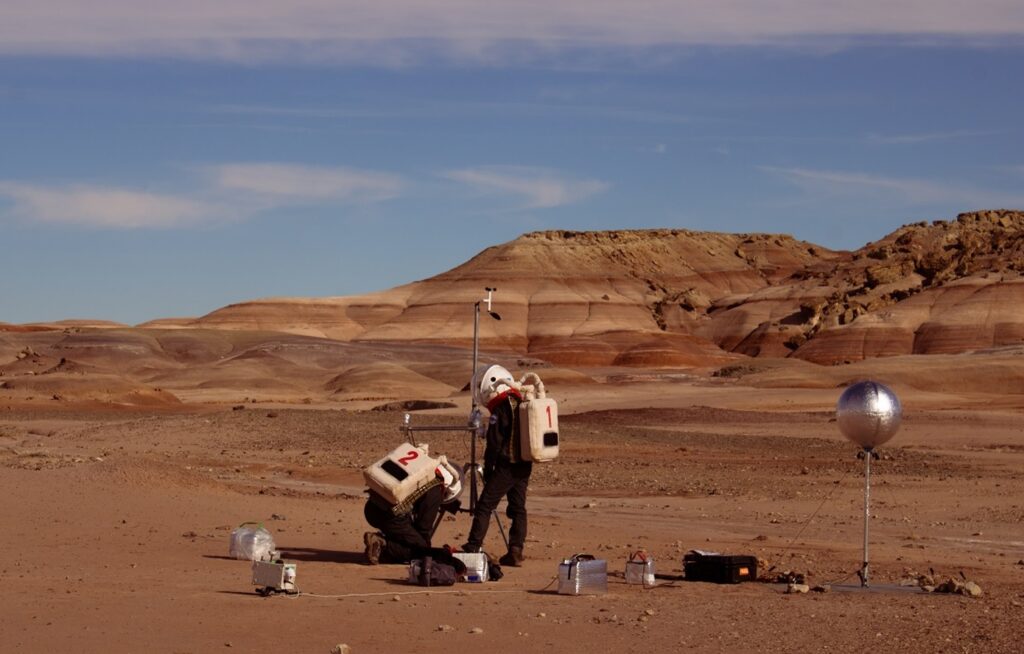
This year’s atmospheric measurement campaign for CNRS researchers was a success. Dealing with rough and unpredictable weather, we had to solve many problems on the spot and adapt to the circumstances. We mainly measured the electric field (with the field mill and MegaAres), the particle concentration in the air (with the LOAC and PurpleAir) and the wind speed (with our weather station), in order to correlate these different parameters. We had difficulties setting up the instruments at the beginning of the simulation because of the snowy or windy weather, and because of a conductivity problem on the MegaAres antenna. We started the measurements at the end of the second week, although we had to perform regular maintenance EVAs to retrieve and reinstall certain sensitive instruments, given the variations in atmospheric conditions. We managed to measure the Canegie curve (daily variation of the Earth’s electric field, measurable in undisrupted and clear conditions which can be observed in the Utah desert), which is usually very difficult to obtain.
Astronomy

The aim of this project was to measure different characteristics of pre-identified asteroids. Unfortunately, as both of the robotic observatories were non-nominal during the entire simulation, or non-operational because of the weather, our crew astronomer could only capture a single picture of an asteroid on February 17th, thus the research project on asteroid lightcurves could not be completed. However, he will continue the project after the simulation, as he still has all of his credits on Skynet. As he couldn’t complete the astronomy project, he used the Musk solar observatory to take pictures of the sun.
Geology: The MetMet instrument

The MetMet is a geological instrument measuring both the magnetic susceptibility and the conductivity of a rock sample. It is designed to help find meteorites, but it has been proven to ease the classification of the different types of rocks present in a given area. The objective of this experiment was to see if the MetMet was a useful instrument to help collect geological samples during EVAs or to take measurements onsite for rocks that are too large to be collected. The idea was to pair the data of the MetMet with photogrammetry in order to geologically map the area. Unfortunately, we could only perform one geology EVA because of external factors. However, this EVA was a success, as we managed to collect samples and to analyze them with the MetMet. We will therefore be able to geologically sketch the area of Kissing Camel Ridge W.
Exploration: Photogrammetry

The idea behind the photogrammetry experiment was to compare the efficiency of humans exploring and finding checkpoints in a given area, using either a 2D map or a 3D render. Each data point required a series of three different EVAs. The first one, to map the area in 3D, with a drone using photogrammetry. The two others were meant for the subjects to find pre-defined checkpoints using the 2D map and then the 3D map generated beforehand. The experiment went very well: we had time to render both North Ridge and Candor Chasma. We nevertheless encountered two issues while conducting these experiments. The EVA with the 2D map at North Ridge was shortened because of the high winds, therefore the EVA Crew managed to find only half of the checkpoints. Moreover, the EVA with the 3D map at Candor Chasma was conducted with only one subject because of external factors. We are quite happy with the data we have already, and we hope to pass on this experiment to the next Supaero crew.
Botany: Aquaponics

For Crew 275, the main botany experiment focused on aquaponics. Indeed, the Crew Botanist worked on a prototype before the mission and tested it for 5 weeks. This prototype was a success, however, as it was a prototype, no scientific data had been collected. He then decided to recreate a similar system in the GreenHab. The space available there being smaller, he decided not to build it with pipes but only with a tank. During the first few Sols, he built the system and ensured the safety of the fish. Then, throughout the mission, he monitored the plants’ growth, the roots’ length, and the water quality to be evaluate the added value of this kind of system. It is expected that plants should grow faster, that water can be saved over time, and that more plants can be grown on a given surface. All the data collected will be processed post-mission and compared to references in aquaponics and basic crops.
Besides this, another experiment was conducted on microgreens. This one was simpler because it only required monitoring microgreens’ growth over time. To do so, we took similar pictures every day with a fixed scale to measure their height. An additional objective was to see if an untrained subject was able to grow these types of crops without knowing anything about botany.
Monitoring Health and Water consumption

During the whole mission, the crew monitored their water consumption. The goal was to reduce as much as possible their use of water, while maintaining good hygiene and drinking as much as needed. With this in mind, we categorized our consumption of water and took note of the quantities used throughout the day. This experiment showed us that by being mindful of our use of water, it is possible to considerably reduce consumption. The average water consumption was 51 L (13.5 gallons) per day. For a crew of 7, this represents 7.3 L (1.9 gallons) per day per person, which could be reduced even more with specific technologies. This is equivalent to a 1-minute shower, and less than a classic toilet flush on Earth (10 L). 50% of the consumption was dedicated to the restroom. Therefore a goal of less than 5 L per person per day could be achieved, including 2 L for drinking purposes.
Every morning, we also measured health parameters to keep an eye on the physical and mental health of the crew. To this end, we kept a sleep diary and monitored weight and body composition, temperature, as well as blood pressure and oxygenation. A 30-minute workout session was then organized by the HSO to keep all crewmembers in good shape and get them ready for the day, thanks to bonding activities and music.
Media Collection and Public Outreach

Our objective for this mission from a communications standpoint was first and foremost to reach middle and high school students interested in space and STEM in general. Throughout the entire mission preparation, the crew worked with OSE l’ISAE Supaero, an outreach initiative whose goal is to help students gain access to higher education and to promote STEM careers. During the entire year preceding the mission, we visited classrooms and welcomed students to our university to talk about space exploration and STEM studies. Our goal was to inspire as many students as possible to explore and engage with scientific fields. In this vein, we spent a week at the Lycée Français de New York with 6th and 10th grade students, using games and simple experiments to share our passion for space.
Other outreach initiatives destined for students included filming video capsules for the Cité de l’Espace, the French space museum, and writing simplified articles on various subjects pertaining to Martian exploration.
Once the mission had started, we focused on the two media visits of the rotation: the BBC and France Télévisions. The BBC film crew stayed for a day to film interviews for a documentary about Martian exploration, while the France Télévisions crew came to film a newscast for French television.











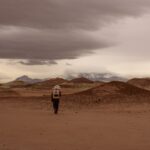
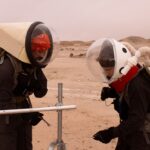
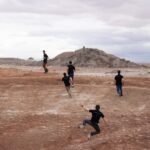

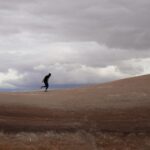
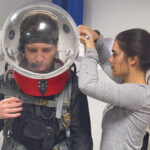
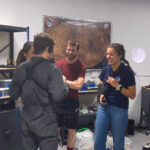
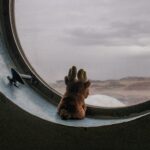
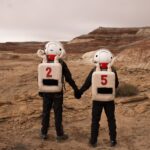
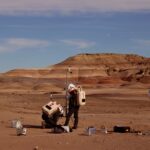
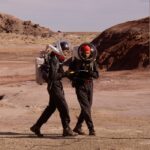
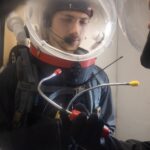
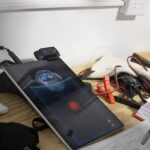
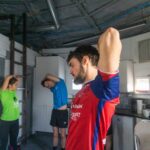
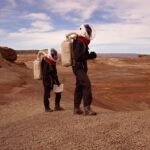
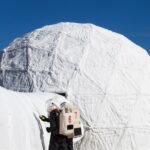
You must be logged in to post a comment.